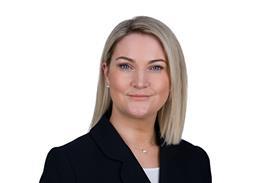The 2014 professional indemnity renewal round was characterised as ‘benign’. After years of turmoil, is the insurance market for solicitors finally stabilising? Eduardo Reyes reports from our latest roundtable.
Professional indemnity insurance has long been a source of unwelcome drama for solicitors.
Over the years, the Gazette has reported hairy episodes, including the ‘black hole’ in the old Solicitors Indemnity Fund (SIF) and the sudden withdrawal from the market of various ‘unrated’ insurers. Last year, we saw the Solicitors Regulation Authority first propose, then withdraw, last-minute changes to PII ‘minimum terms’.
Obtaining cover, we can reasonably conclude, has often proved to be far from straightforward. But – whisper it – is the market now enjoying a period of stability?
Problems remain, attendees at the Gazette’s PII roundtable point out, but the broader picture is encouraging. Insurance broker Mark Carver, a partner at broker Miller Insurance Services, sets the scene: ‘It’s useful to look back and see what happened in 2014. My view as an adviser is, if we consider everything that went on around this time last year, from the insurance perspective the eventual outcome was a credit to the industry.’
Considering the SRA’s ‘ill-timed and ill-formed consultation’, he adds, the insurance industry ‘reacted well, was flexible, and was creative in terms of solutions’.
As a result, Carver concludes: ‘I look at the market as being incredibly benign last year. I don’t think there were issues around firms being unable to get coverage. And I don’t think firms were shocked at the levels of premium that they were being potentially charged.’ From a pricing perspective, he notes, ‘it was pretty flat’.
Carver partly attributes that environment of stability to ‘unrated insurers beginning to fall back’. This is not so much because law firms were better educated about the risks of using an unrated insurer, but more a case of greater availability of cover from rated insurers and the attitude of the banks towards firms who opt for unrated insurers.
Particular ‘dynamism’ was observable in the five-partner-plus sector of the mid-market, with insurers moving to impose a rate increase at the start of the renewals ‘season’ before later relenting.
Carver adds: ‘We increasingly saw the use of co-insurance [where two or more insurance firms share the risk] for some of the larger risks, which from an advisory perspective is a good thing. It spreads exposure. I think we saw some of the traditional mid-market [insurers] begin to move into that, which is good. It’s probably the first time since the open market that [those with] the larger risks have begun to have more of a choice outside of the traditional big three underwriters.’
Underwriter Aviva’s Trevor Meadowcroft confirms the picture described by Carver, but also notes a marked shift in the price sensitivity of PII. ‘When you actually meet the clients, one of the key things they focus on is how you handle the claims. Because it’s the one thing that solicitors will have, even if they’re not at fault – they will have claims. They will have situations where people, correctly or not, are disgruntled.’
Price-sensitive behaviour
Lucy Tolond, a partner in BLM’s professional indemnity team, references the experiences that are driving less price-sensitive behaviour: ‘When we speak to insureds that have claims made against them, they do make the comment that actually, the claims experience they get from insurers is a big differentiator. It’s not just price that they’re choosing on now.’
DWF partner Michele Malson cites two related issues around value. First, ‘for quite a few insurers who I talk to, one of the great benefits of a good claims-handling service is the time saving for them, because it’s a very big time investment to deal with claims’.
Second, this also makes the law firm’s life easier. ‘If you have a good claims-handling service as part of your insurance, it allows the firm to put more time and effort into risk management,’ she says. In consequence a firm can ‘begin to see their insurance more as part of their business’.
By contrast, the smallest firms remain in a relatively unenviable position, Legal Risk partner Frank Maher notes: ‘Where the difficulties arise are the small firms with the large claims. I don’t think that when the profession voted to end SIF, it really foresaw or thought through the impact that the open market would have for a small firm.’
Maher adds: ‘If you get a large firm with a fairly large claim, they’ll still get insurance. When you’ve got a small firm with a bad claims experience, then [it can be] total wipeout. They become unattractive very quickly, and especially when it happens more than one year in a row.
‘I’m even aware of one firm that was intervened in by the SRA because an insurer didn’t pay out,’ Maher recalls. ‘So, you definitely get what you pay for.’
Market research, the roundtable acknowledges, indicates that cost is the main factor in selecting an insurer for 21% of law firms – a fall from a previous high of 58%.
Job done, perhaps? Not so, says the Law Society’s director of policy Mark Stobbs: ‘It’s been a good year, but we know it’s a cyclical market – there will be difficult times coming up.’
While the problem of ‘firms who really should not have been practising staying in the ARP [assigned risks pool] for years has been sorted out’, Stobbs cautions: ‘The big issue for the profession now is the one which has been stimulated by the SRA. That is the question of how far the profession is prepared to cover itself and its unreliable colleagues’ risks, and how far, ultimately, it’s prepared to have the headlines of “widows and orphans left destitute” because of their negligent solicitor. Which the present system prevents.’
He argues: ‘It’s very hard to see how any of the SRA’s proposals will avoid that happening.’
It is quite wrong, Maher believes, to think the market can be divided into ‘good’ and ‘bad’ firms. ‘It’s very easy to see a firm that’s got a large claims figure on its record as a bad firm, but in my experience they’re not invariably bad firms,’ he says. Instead, ‘they’re firms that have been unlucky in a lot of cases.
‘Most of the firms that I’ve advised who’ve had a rogue partner who’s gone off the rails and left a trail of destruction, have had Lexcel and CQS. So, on the face of it, they’re very good firms and they are managing themselves properly. But we’re talking about managing risk, not eliminating it.’
At the table
Eduardo Reyes, Law Society Gazette; Yasbinder Sihan, IBB Solicitors; Michael Howard, Browne Jacobson; Mark Stobbs, The Law Society; Michele Malson, DWF; Frank Maher, Legal Risk; Trevor Meadowcroft, Aviva; Tim Norman, Chancery Pii; Lucy Tolond, BLM; Mark Carver, Miller Insurance Services; Paul Nolan, Allianz Global
Relationship matters
The discussion turns to developments in law firms’ relationships with their broker – the importance of which is augmented by the need to explain the ‘unlucky’ incidents alluded to by Maher.
As an underwriter, Meadowcroft observes some changes here, not least a shift towards a more meaningful ‘year-round’ relationship between broker and client. ‘A key part of this is the way that the solicitor interacts with their broker – creating the opportunity for them to be able to present the risk to the underwriters on a full-time basis,’ he notes.
Helpful in that process is the end of the single renewal date, Meadowcroft adds: ‘You used to have that ultimate cut-off date – it had to be sorted out by 1 October. Whereas now you can ask for extensions. You can say, “we need a bit more time to sort this out”. You can create an environment in which the broker has got the time to actually present the risk in the best possible light.’
IBB’s quality and compliance manager, solicitor Yasbinder Sihan, interjects: ‘I do a lot of analysing. We look at the types of claim, the history of claims, the pattern. I sort analysis team by team. Certain teams, like the commercial and litigation teams, are higher risk. Funded teams, such as crime and family – and personal injury – are fairly low risk. So we develop charts and analysis.’
Insurers, she says, ‘really like the fact that we’re risk-assessing’. Where there is a pattern of risk, developing internal training on risk is prioritised.
‘We’re constantly changing the client care letters to coincide with what the brokers want,’ Sihan adds. ‘So it’s a work in progress – risk assessment that’s being maintained.’
She acknowledges that ‘from a compliance point of view, not all law firms are in a position where they can afford to employ internal compliance teams’. But she concludes: ‘Certainly in the long term, it seems to be the way things are going to have to develop.’
Firm size aside, the mindset that accompanies that approach could still be applied more widely. Sihan summarises this as ‘trying to be proactive rather than reactive’ in identifying and managing relevant risks.
Through dialogue, brokers and insurers will provide a sense of what they are seeking in a risk assessment that year, Sihan adds. ‘They will look at our plans and ask, “how do you propose you’re going to implement that in this coming year?”. We’ll have a discussion and seek their approval. In response to the firm’s ideas, they may say, “yes, actually, if you tweak it this way, we’d be happy with that”. We’re working very, very closely with them.’
There is also, Sihan reports, more informal co-operation between law firms. Practitioners are increasingly willing to assist one another with advice and sharing experiences. That masks a rump of firms whose renewal remains an annual ‘rush’. For those firms, filling in the relevant forms will be more arduous.
Responding to Sihan, Browne Jacobson partner Michael Howard notes that ‘about a fifth of firms had complaints about the level of form filling’. He adds: ‘That suggests to me that there’s a large group of law firms who are shying away from the kind of rapport that you’re building’.
The need for tolerance in form filling will increase, Howard adds: ‘With the insurance act coming next year, there’s likely to be an increase in the level of questions.’ In this context, Meadowcroft urges solicitors to exercise a degree of empathy as they engage with the process: ‘What solicitors should be doing is considering why they are being asked such and such a question.’
He cites questions on IT security as an example. These will increasingly feature on application forms and with good reason, given the enhanced risk of breaches in client confidentiality and the need to protect client money in a world that is reliant on online transfers.
But Tim Norman, director of Chancery Pii, believes longer question-sets should not be automatically accepted by the market. Not least because a focus on superfluous questions might obscure those that relate to the most relevant risks.
‘We’ve looked at that this year and said, actually, there are probably eight or nine questions in there that insurers don’t tend to focus on. We can’t expect our clients to answer 35-40 page questionnaires [when] the majority don’t add too much value. What we want to look at is the risk management.’
There is an impact on choice when the process is too onerous, Norman adds: ‘We then [in effect] restrict choice, because firms don’t want to go to two insurers and two brokers and have to complete two proposal forms.’
He also points out that ‘a question set gives a very narrow perception of what a firm is’, adding: ‘Every single one of our clients will either be spoken to on a regular basis, or will be met… you get a much better feel for what that firm is like by speaking to them or seeing something in writing.’
There is still the need and the place, the underwriters and brokers present note, to provide a ‘narrative’ for a firm, explaining its risk profile, its record and its business compliance plan.
As already noted, one new area in that narrative relates to a firm’s IT security. Meadowcroft observes: ‘One of the interesting things about cyber-exposures is that if you’ve got four underwriters into a room, you’d probably get five definitions of what cybersecurity is. But it is part of the picture.’
Sihan notes that while firms need a solid narrative in dialogue with brokers and underwriters, the ability to list respected accreditations is helpful. ‘We as a firm have ISO 9001, CQS, [and] Lexcel,’ she says. ‘The reason we’ve gone down that route is that we’ve found that the insurers really embrace these types of accreditation.’
It is significant, she notes, that the requirements of the firm’s proposal form ‘coincided closely with [those of] Lexcel’.
Regulatory concerns
Norman notes that the key aim for all parties in the market should be to create a period of stability. In that context, there are harsh words for the SRA’s decision to consult on changing the ‘minimum terms and conditions’ in the midst of 2014’s renewal round. As Allianz Global’s Paul Nolan puts it: ‘The timing of last year’s consultation was shocking. It put everyone on the back foot, in terms of assessing the potential impact.’
Howard adds: ‘It takes a long time to sort out rating, reinsurance, policy wordings. It’s not something that you can arrange in a fortnight or three months. I think there was an expectation that it could be turned around on a pinhead, when it can’t.’
Maher is also scathing: ‘The important thing is, before [the SRA] start talking about changes in rules, they need to understand the rules that they’re proposing to change. It was quite apparent last year that they didn’t, because when they proposed the reduction to £500,000 in cover they didn’t realise that would include costs. That really is quite woeful.’
Lessons seem to have been learnt by the regulator, attendees who deal with the SRA relate. ‘It’s only fair to say that I have noticed a change in the approach of the SRA towards insurers over the last couple of months,’ Meadowcroft says. ‘I think they’ve learnt the lessons.’
Client protection
The test as to whether lessons have indeed been learnt will come when a draft paper on ‘client financial protection’ is published in the next few weeks – the start of a consultation that could lead to reform of the minimum terms and conditions.
‘I think it’s interesting that they’ve taken so long to get it out,’ Stobbs says. ‘This was originally going to come out late last year. I think they realised how difficult it is to unpick a system which does provide pretty much complete protection to clients.’ Abandoning that, he suggests, would have ‘significant reputational issues for the profession’.
‘I wouldn’t like to tinker with it too much,’ Maher responds, ‘because by and large it’s working.’
One of the other solicitors present notes: ‘I deal with claims made against financial advisers, and I do on occasion have to write to claimants and say, “I’m sorry, but this claim’s not covered. You may have a recourse to the Financial Services Compensation Scheme, or you may not, depending on what kind of product you’ve been advised to invest in.” I wouldn’t like solicitors to be in that position, frankly.’
For small firms there is an argument for insurance products being developed that temper the terms of the mandatory six-year run-off cover, which is of particular concern for one- and two-partner practices. It should be possible to structure such a product, Howard suggests, through ‘some kind of staged payment’. ‘The majority of claims come in the first three years,’ he explains. ‘You could stage it in various levels, going down over a six-year period.’
That may be possible for firms that are currently operating, though a particular concern remains SIF’s legacy provision. Howard asks: ‘What is going to happen when SIF runs out of money, which will happen between 2020 and 2023?’
Residential conveyancing
Another concern for brokers, underwriters and solicitors has been the risks associated with conveyancing claims. And at the root of the problem are the basic economics of the sector. As Howard notes: ‘It is still a drive to the bottom on cost. It’s still a very commoditised practice, and I think because of that, corners will be cut and errors will be made.’
Conveyancing is, he notes, ‘a very, very specialist and difficult area’ and fees that are sometimes below £300 therefore do not reflect the risk.
Tolond adds: ‘It’s extraordinary when you’re buying what might be the most valuable asset you’ll ever own to take issue [with] paying £400 instead of £800.’
That point is borne out by aspects of the claims she encounters: ‘There are quite complicated points that come up that are expected to be dealt with in a commoditised transaction by someone who may have very little experience.’
PII health check
Ready for discharge
- PII premiums – across the board the expectation is for price stability in this year’s renewal season.
- Respected accreditations – now widely recognised by insurers as providing evidence of good risk management.
- Personal injury practices – deemed to have a broad grip on managing the risks that solicitors incur.
Under observation
- Cybersecurity – an emerging area of risk.
- Regulation – all eyes will be on the SRA’s consultation on client financial protection.
- New rated insurers – one, with limited capacity, is said to be preparing to enter the market.
- Unrated insurers – solicitors are focusing more closely on what service and value they can obtain from rated insurers. The importance of price in purchasing cover has fallen.
In a critical condition
- SIF – funds available to pay claims from the Solicitors Indemnity Fund are predicted to run out between 2020 and 2023.
- Conveyancing practices – high risks and low margins continue to be a concern.
‘If you’re only getting that amount of money, you’re not going to have the highest level of lawyer or partner dealing on that transaction,’ Carver observes. Around 10% of conveyancing fees will go towards a solicitor’s PII cover, against a background of property values that have increased significantly – in turn increasing the value of property-related claims.
But even within such confines, Maher argues, more could be expected from conveyancing practices: ‘It is a worry that the mistakes made by conveyancers now are the same ones they made in the 1990s. Nothing has changed.’
By contrast, he adds: ‘The personal injury litigators seem to have got a grip on the fact there’s a three-year time limit for claims. But, for example, the conveyancers don’t seem to have grasped the fact that they’ve got to report if there’s been a prior transaction in the past six months; [one of the] basics contained in the CML handbook.’
New entrants
The discussion turns back to market capacity and a key question: what would tempt more rateable insurers into the market, increasing capacity and, through competition, reducing premiums?
While some of the legal insurance market’s ‘water-tight’ aspects support stability, it is pointed out that insurers face a more open-ended commitment than they do in other professional indemnity markets.
As Meadowcroft explains: ‘One of the challenges when you underwrite solicitors is you have a risk that you don’t have with any other class of professional indemnity – a credit risk.’ He continues: ‘If they don’t pay the premiums you’ve still got to insure them. If they don’t pay the excess, you fund the excess. If they go bust, you’ve got to give them six years’ runoff cover.’
He adds: ‘With any other class of professional indemnity insurance we don’t fund the excesses, we don’t need to give cover if they don’t pay the premium. We’re taking on a credit risk [with solicitors], not just an underwriter risk. That’s why insurers started asking for copies of accounts. You need to know what you are actually underwriting.’
As a result, Howard responds, while he’s ‘heard there’s another [rated insurer] coming to market this year’ the effect will ‘not be massive’.
Can smaller firms, lacking the capacity that Sihan has outlined for IBB, successfully outsource their risk and compliance needs? In operational terms only, Maher argues: ‘You can never outsource it. You’ve always got the responsibility. You can get help with it – that’s something that we do for other firms. But firms can’t outsource it to us, they can’t just walk away from it.’
In terms of claims, unrated insurers that have exited the market continue to cause headaches, undermining confidence in solicitors as a well-regulated and ‘guaranteed’ professional group.
Howard explains: ‘I’ve heard that there have been significant problems in trying to get responses from [some] unrated insurers from their claims departments, in particular in claims related to fraud.’
An imperfect market
Greater stability is clearly welcome in the PII market, but for many seeking cover the market remains indubitably flawed. Brokers, Howard points out, do not meet the expectation that they have general access to the market. ‘Of course they haven’t,’ he notes. ‘They’ve got their own schemes, which is interesting and problematic.’
Exclusive arrangements on PII products have, he says, generally been a feature of the ‘lower end’ of the market. But this is now creeping into the mid-market, adding a further element of dysfunction. ‘If you look at exclusive arrangements, they tend to fail,’ Howard warns.
And while the end of a single renewal date is generally welcomed, it has an unfortunate byproduct, Norman notes. He asks whether all firms considering a different renewal date are ‘getting alternative quotes’, and therefore ‘don’t know if those prices are… competitive’.
He cautions: ‘I think you’ve got to be very careful whether [the deal is] being done for the benefit of an insurer, for a broker’s income, or for the firm.’
Eduardo Reyes is Gazette features editor
- This roundtable was kindly sponsored and hosted by Chancery Pii

















![Emily-1[17]](https://d1d8vslyhr7rdg.cloudfront.net/Pictures/274x183/3/1/7/120317_emily117_695594_crop.jpg)






















11 Readers' comments